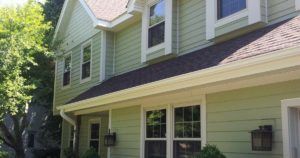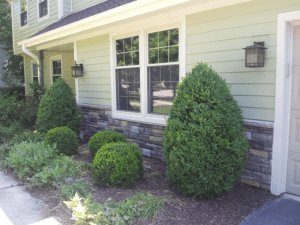Container gardening is a fun way to add curb appeal to porches, entries, patios, and home exteriors. The key ingredients to a successful container garden are the right container and happy plants.
Container Materials
Selecting the best container for your needs and style is essential. An important factor to consider is whether you plan to move it frequently. If so, then choose something lightweight or consider keeping the container on wheels. Lets go over the ins and outs of
the different popular container materials.
Wood
Wooden containers are nice because you can customize them to your needs by adding hooks, paint, or whatever you want. You can even add the same siding that is on your house for a seamless look! Wood will also hold a large amount of weight and withstand UV rays better than plastic. They will rot over time, so make sure to choose a wood like Cedar, Acacia or Teak for maximum longevity.
Lightweight Composites and Durable Plastics
Composites are very popular for container gardening. They are often the lightest in weight and designed for maximum durability. These are often readily available at many garden stores. Added bonus, some composites are eco-friendly and/or made with recycled materials.
Terracotta, Ceramic & Clay
These are going to be sturdy and weighted, making them less likely to fall over. This type of pot is fun for design, because many of them are glazed and painted. There are many different shapes and styles to choose from. They are also permeable and breathable, so they are a healthy option for plants. They are brittle and can crack, especially under weather extremes. It’s a good idea to bring this type of pot in during freezing temperatures.
Other great container options:
- Metal like galvanized steel
- Wire baskets with coir fiber inserts
- Upcycled containers! Bathtubs, BBQ grills, teapots, suitcases, boots, old milk crates, whatever interesting things you can find!
Questions? Call 847-380-8868 in Des Plaines and 888-676-6725 in Naperville
 Tips for healthy potted plants
Tips for healthy potted plants
- Use a well draining container
- Choose a light potting mix (not garden soil or top soil). This ensures a lightweight mix that drains properly.
- Pick plants that do well in containers. Avoid plants that make deep roots. Annuals are usually best for container gardening.
- Use a light fertilizer. Don’t over fertilize, it can kill the plants. I like to pick a slow release organic fertilizer, so I only have to add it once. Some potting soils come pre-fertilized, so make sure to read the labels. You can also add a little compost to your potting mix. Be sure to choose an OMRI listed product for safety and environmental friendliness.
- Keep it watered. Make sure to water your containers regularly, especially when the weather is hot and dry. Containers can dry out quickly. You can consider a self watering planter that will require less watering.
Now sit back and admire your gorgeous container garden!


 Tips for healthy potted plants
Tips for healthy potted plants


